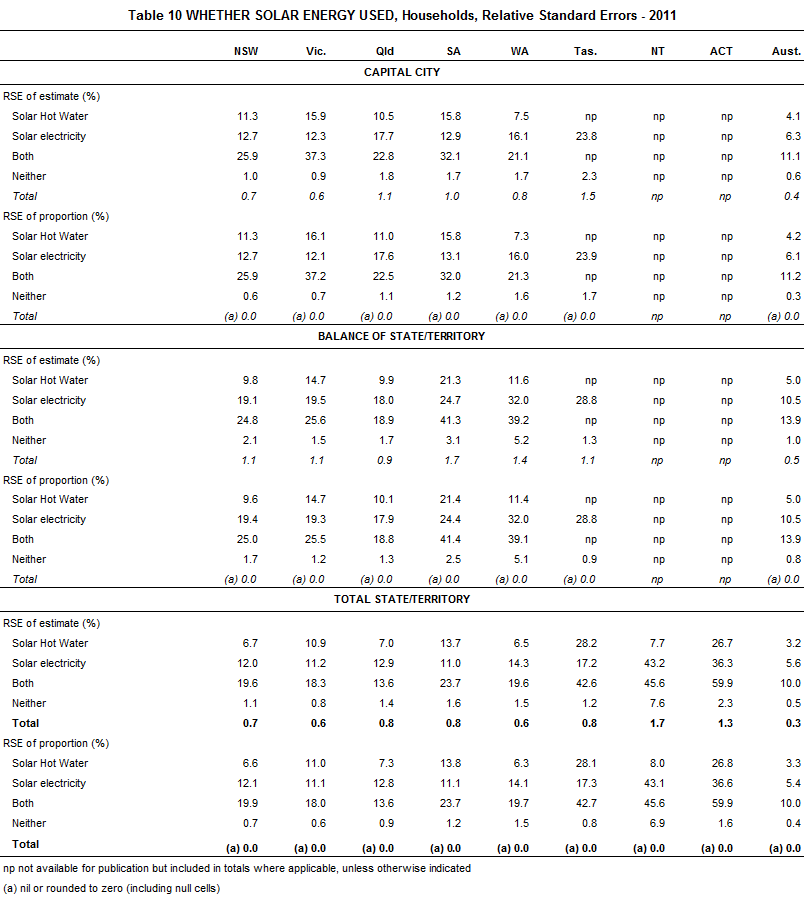TECHNICAL NOTE DATA QUALITY
RELIABILITY OF THE ESTIMATES
1 Since the estimates in this publication are based on information obtained from a sample, they are subject to sampling variability. That is, they may differ from those estimates that would have been produced if all dwellings had been included in the survey. One measure of the likely difference is given by the standard error (SE), which indicates the extent to which an estimate might have varied by chance because only a sample of dwellings (or households) was included. There are about two chances in three (67%) that a sample estimate will differ by less than one SE from the number that would have been obtained if all dwellings had been included, and about 19 chances in 20 (95%) that the difference will be less than two SEs.
2 Another measure of the likely difference is the relative standard error (RSE), which is obtained by expressing the SE as a percentage of the estimate:

3 RSEs for estimates from 2011 Environmental Issues: Energy Use and Conservation have been calculated using the Jackknife method of variance estimation. This involves the calculation of 30 'replicate' estimates based on 30 different subsamples of the obtained sample. The variability of estimates obtained from these subsamples is used to estimate the sample variability surrounding the estimate.
4 A Data Cube (spreadsheet) containing all tables produced for this publication is available free-of-charge on the ABS web site <www.abs.gov.au>. The Data Cube also contains directly calculated RSEs for the 2011 estimates. For illustrative purposes the RSEs for Table 10 have been included at the end of these Technical Notes.
5 Only estimates (numbers and proportions) with RSEs less than 25% are considered sufficiently reliable for most purposes. Estimates with RSEs between 25% to 50% have been included and are annotated to indicate they are subject to high sample variability and should be used with caution. In addition, estimates with RSEs greater than 50% have also been included and annotated to indicate they are considered too unreliable for general use.
CALCULATION OF STANDARD ERROR
6 SEs can be calculated using the estimates (counts or proportions) and the corresponding RSEs. For example, Table 10 shows that the estimated number of households in Australia that used solar hot water in their dwelling was 602,700. The RSE corresponding to the estimate in Table 10 (see Relative Standard Errors in the 'Relative Standard Error' section at the end of these Technical Notes) shows the RSE for this estimate is 3.2%. The SE is calculated by:

7 Therefore, there are about two chances in three that the actual number of households that used solar hot water in their dwelling was in the range of 583,400 to 622,000 and about 19 chances in 20 that the value was in the range 564,100 to 641,300. This example is illustrated in the diagram below.

PROPORTIONS AND PERCENTAGES
8 Proportions and percentages formed from the ratio of two estimates are also subject to sampling error. The size of the error depends on the accuracy of both the numerator and the denominator. A formula to approximate the RSE of a proportion is given below. The formula is only valid when the numerator is a subset of the denominator.
![Equation: RSE(x/y) = square root of ([RSE(x)] squared - [RSE(y)] squared)](/ausstats/abs@.nsf/0/43f31ffd76a87cc1ca257da2000d1e8e/Body/0.2A40!OpenElement&FieldElemFormat=gif)
9 As an example, using estimates from Table 10, of the 8,601,500 households in Australia, 1.5%, that is 124,700 households use both solar hot water and solar electricity in their dwelling. The RSE for 124,700 is 10.0% and the RSE for 8,601,500 is 0.3% (see Relative Standard Errors Table in the 'Relative Standard Error' section at the end of these Technical Notes). Applying the above formula, the RSE for the proportion of households that use both solar hot water and solar electricity in their dwelling is:

DIFFERENCES
10 Published estimates may also be used to calculate the difference between two survey estimates (numbers or proportions). Such an estimate is also subject to sampling error. The sampling error of the difference between two estimates depends on their SEs and the relationship (correlation) between them. An approximate SE of the difference between two estimates (x-y) may be calculated by the following formula:
![Equation: SE(x-y) = square root of ([SE(x)] squared + [SE(y)] squared)](/ausstats/abs@.nsf/0/43f31ffd76a87cc1ca257da2000d1e8e/Body/0.33A0!OpenElement&FieldElemFormat=gif)
11 While this formula will only be exact for differences between separate and uncorrelated characteristics or sub-populations, it provides a good approximation for all differences likely to be of interest in this publication.
SIGNIFICANCE TESTING
12 A statistical significance test for any comparisons between estimates can be performed to determine whether it is likely that there is a difference between two corresponding population characteristics. The standard error of the difference between two corresponding estimates (x and y) can be calculated using the formula in paragraph 10. The standard error is then used to create the following test statistic:
![Equation: [(modulus(x-y))/SE(x-y)]](/ausstats/abs@.nsf/0/43f31ffd76a87cc1ca257da2000d1e8e/Body/0.3892!OpenElement&FieldElemFormat=gif)
13 If the value of this test statistics is greater than 1.96 then we may say there is good evidence of a real difference in the two populations with respect to that characteristic. Otherwise, it cannot be stated with confidence that there is a real difference between the populations.
RELATIVE STANDARD ERROR
14 The RSEs for Table 10 are included below:

 Print Page
Print Page
 Print All
Print All
 Quality Declaration
Quality Declaration